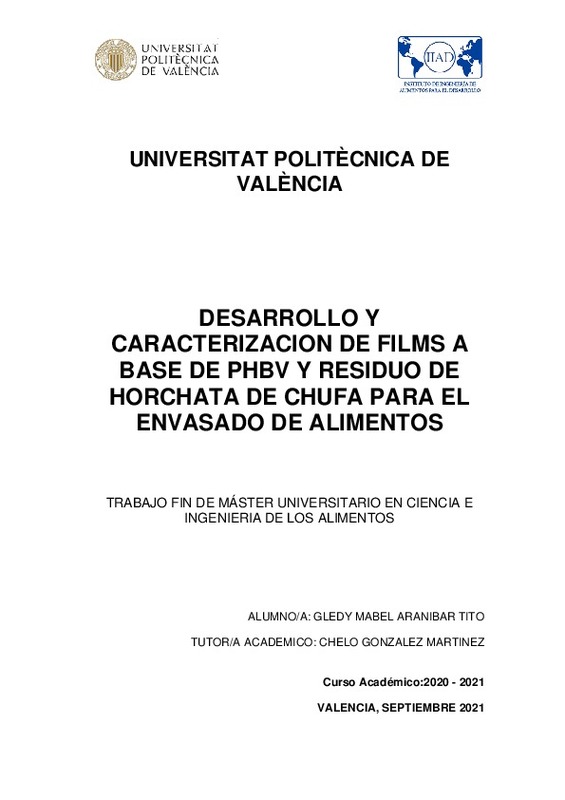JavaScript is disabled for your browser. Some features of this site may not work without it.
Buscar en RiuNet
Listar
Mi cuenta
Estadísticas
Ayuda RiuNet
Admin. UPV
Desarrollo y caracterización de films a base de PHBV y residuo de horchata de chufa para el envasado de alimentos
Mostrar el registro sencillo del ítem
Ficheros en el ítem
| dc.contributor.advisor | González Martínez, María Consuelo
|
es_ES |
| dc.contributor.advisor | Contreras Monzón, Carolina Ivonne
|
es_ES |
| dc.contributor.author | Aranibar, Gledy Mabel
|
es_ES |
| dc.date.accessioned | 2021-10-13T14:48:58Z | |
| dc.date.available | 2021-10-13T14:48:58Z | |
| dc.date.created | 2021-09-23 | |
| dc.date.issued | 2021-10-13 | es_ES |
| dc.identifier.uri | http://hdl.handle.net/10251/174610 | |
| dc.description.abstract | [ES] El objetivo de este trabajo es desarrollar y caracterizar films biodegradables mezclando diferentes proporciones del residuo de la elaboración de horchata de chufa con PHBV. Para ello, se optimizaron los ratios residuo: PHBV que permitiera obtener film manejables. Con ello, se obtuvieron film con diferentes ratios PHBV:residuo y se caracterizaron en términos de propiedades mecánicas y barrera, contenido en humedad y solubilidad, termo-sellabilidad y color. Los resultados mostraron el efecto de la incorporación del residuo en el film de PLA. | es_ES |
| dc.description.abstract | [EN] In the present work, PHBV-based films containing 0 (control), 10, 20 and 30% of tigernut residue obtained after the production of "horchata" were developed by thermocompression molding. Films were characterized in terms of thickness, moisture and phenolic content, solubility, water vapor and oxygen permeabilities, mechanical and optical properties, antioxidant capacity and microstructure by FESEM. The results showed that it is possible to substitute up to 30% the PHBV using horchata residue to obtain films, although such substitution worsened the physicochemical properties, since they became mechanically less resistant and stretchable, with lower water vapor and oxygen barrier capacities, higher opacity, lower gloss and higher water solubility. Of the three treatments evaluated, the film incorporating 10% horchata residue was the one that presented the best functional properties, since their properties were closer to the ones of the control film, while preserving the oxygen barrier capacity. | es_ES |
| dc.format.extent | 17 | es_ES |
| dc.language | Español | es_ES |
| dc.publisher | Universitat Politècnica de València | es_ES |
| dc.rights | Reserva de todos los derechos | es_ES |
| dc.subject | Capacidad antioxidante | es_ES |
| dc.subject | Termoprocesado | es_ES |
| dc.subject | PEG1000 | es_ES |
| dc.subject | Tensión de fractura | es_ES |
| dc.subject | Módulo de elasticidad | es_ES |
| dc.subject | Solubilidad | es_ES |
| dc.subject | Color | es_ES |
| dc.subject | Fenoles | es_ES |
| dc.subject | Thermoprocessing | es_ES |
| dc.subject | Fracture toughness | es_ES |
| dc.subject | Modulus of elasticity | es_ES |
| dc.subject | Solubility | es_ES |
| dc.subject | Phenols | es_ES |
| dc.subject | Antioxidant capacity | es_ES |
| dc.subject.classification | TECNOLOGIA DE ALIMENTOS | es_ES |
| dc.subject.other | Máster Universitario en Ciencia e Ingeniería de los Alimentos-Màster Universitari en Ciència i Enginyeria Dels Aliments | es_ES |
| dc.title | Desarrollo y caracterización de films a base de PHBV y residuo de horchata de chufa para el envasado de alimentos | es_ES |
| dc.type | Tesis de máster | es_ES |
| dc.rights.accessRights | Abierto | es_ES |
| dc.contributor.affiliation | Universitat Politècnica de València. Departamento de Tecnología de Alimentos - Departament de Tecnologia d'Aliments | es_ES |
| dc.contributor.affiliation | Universitat Politècnica de València. Escuela Técnica Superior de Ingeniería Agronómica y del Medio Natural - Escola Tècnica Superior d'Enginyeria Agronòmica i del Medi Natural | es_ES |
| dc.description.bibliographicCitation | Aranibar, GM. (2021). Desarrollo y caracterización de films a base de PHBV y residuo de horchata de chufa para el envasado de alimentos. Universitat Politècnica de València. http://hdl.handle.net/10251/174610 | es_ES |
| dc.description.accrualMethod | TFGM | es_ES |
| dc.relation.pasarela | TFGM\146215 | es_ES |
Este ítem aparece en la(s) siguiente(s) colección(ones)
-
ETSIAMN - Trabajos académicos [3555]
Escuela Técnica Superior de Ingeniería Agronómica y del Medio Natural






